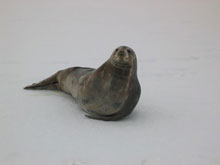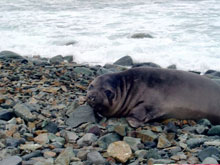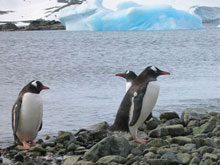A large Weddell seal (Leptonychotes wedellii) stretched out on the snow. Click image for larger view and image credit.
King George Island, Antarctic
December 4, 2005
William Hanshumaker
Oregon State University
Public Marine Education Specialist
Extension Sea Grant Faculty
Weather: Overcast with temperatures hovering near
freezing,
Winds: 30-40 knots with wind gusts up to 60
We gathered this morning for a hike to the nearest penguin colony. Though told yesterday to stay within 1 km of the base, we were permitted to go farther since dangerous weather wasn't threatening. The wind chill factor required that we dress in multiple layers of clothing. By following the shoreline, much of the snow and ice were avoided, but strong wind gusts frequently swept up freezing ocean spray.
A female Southern elephant seal (Mirounga leonine) to exception to our presence. Click image for larger view and image credit.
Several small, beautifully sculpted icebergs floated nearby in the bay. Multi-colored lichen decorated the large rocks along the rocky path that we were following. In spite of its proximity to the shoreline, I was told that this trail is only passable 3-4 months of the year. Not surprisingly, many animals take advantage of this opportunity to leave the sea for breeding and foraging. We almost immediately encountered a large Weddell seal (Leptonychotes weddellii) stretched out on the snow. We were able to closely approach this male without disturbing his repose. However, the smaller female Southern elephant seal (Mirounga leonine) that was lying closer to the shore took exception to our presence, but only reacted by moving slightly farther away.
It was the diverse bird life we encountered that generated the most excitement. Antarctic tern (Sterna vittata) nests were located within a meter of the trail. Their camouflaged eggs required a sharp eye to avoid being stepped upon. (See if you can find the eggs.) If it weren’t for the sharp cries from the parents, we would not have been alerted to the presence of their nests. Much more obvious were the large, nesting Southern Giant Petrel (Macronectes giganteus). Though these birds also nest on the ground, they refused to leave their eggs as we approached.
The stars of King George Island are the penguins. Here three Gentoo penguins (Pygoscelis papus) were photographed near the waters edge. Click image for larger view and image credit.
The stars of King George Island are undoubtedly the penguins. Though Adelie penguins (Pygoscelis adeliae) are also commonly found here, we encountered just two different species: the Gentoo (Pygoscelis papus) and Chinstrap penguins (Pygoscelis antarctica). The occasional Chinstraps we observed were either in the water, or on the adjacent coastline.
Because of the presence of their breeding colony, the Gentoo penguins were much more obvious. To avoid predation, the penguins located their breeding colony away from the shoreline, up a moderately steep, snow-covered hill. Their nests are composed of small rocks, which are arranged around the reclining body of the penguin. Enough distance to inhibit interactions between the different nesting parents separates each nest. I was fortunate to observe the apparent "changing of the guard". When one parent returned from foraging at sea, both birds stood and faced each other, called and flapped their wings, before exchanging places on the nest. The other parent then waddled back down the trail to the sea to feed.
While we do not have penguins in the Pacific Northwest, there are many diving birds that have similar appearance. In fact, the common murre, the most abundant bird off of the Oregon coast, is often mistaken for a penguin. The murres' counter-shading, with a black back and white chest, is identical to that of the penguins'. This helps protect birds of both hemispheres from predation, while camouflaging them from their prey. But there are important differences as well. While each Pacific Northwest species generally uses a specific nest type and site, penguins help maintain ecological segregation by breeding at different times. I'll just have to return to King George Island at another time in order to encounter different penguins.
Sounds of the Southern Ocean will be sending several reports from Dec 3 - 13. Please check back for additional logs from this expedition.
Sign up for the Ocean Explorer E-mail Update List.















